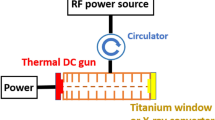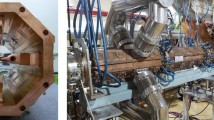Abstract
A high-intensity continuous-wave (CW) radio frequency quadrupole (RFQ) accelerator is designed for boron neutron capture therapy. The transmission efficiency of a 20-mA proton beam accelerated from 30 keV to 2.5 MeV can reach 98.7% at an operating frequency of 200 MHz. The beam dynamics have a good tolerance to errors. By comparing the high-frequency parameters of quadrilateral and octagonal RFQ cross sections, the quadrilateral structure of the four-vane cavity is selected owing to its multiple advantages, such as a smaller cross section at the same frequency and easy processing. In addition, tuners and undercuts are designed to tune the frequency of the cavity and achieve a flat electric field distribution along the cavity. In this paper, the beam dynamic simulation and electromagnetic design are presented in detail.










Similar content being viewed by others
References
G.L. Locher, Biological effects and therapeutic possibilities of neutron. Am. J. Roentgenol. 36, 1 (1936)
R.D. Rogus, O.K. Harling, J.C. Yanch et al., Mixed field dosimetry of epithermal neutron beams for boron neutron capture therapy at the MITR-II research reactor. Med. Phys. 21, 1611–1625 (1994). https://doi.org/10.1118/1.597267
Y. Kasesaz, H. Khalafi, F. Rahmani et al., A feasibility study of the Tehran research reactor as a neutron source for BNCT. Appl. Radiat. Isot. 90, 132–137 (2014). https://doi.org/10.1016/j.apradiso.2014.03.028
I.M. Kapchinskii, V.A. Teplyakov, A linear ion accelerator with spatially uniform hard focusing, 1–17 (1969)
T.P. Wangler, J.E. Stovall, T.S. Bhatia, et al., Conceptual design of an RFQ accelerator-based neutron source for boron neutron-capture therapy, in Proceedings of the 1989 IEEE Particle Accelerator Conference, vol. 1, pp. 678–680 (2002). https://doi.org/10.1109/PAC.1989.73220
P.A. Posocco, M. Comunian, E. Fagotti, A. Pisent, TRASCO-RFQ as injector for the SPES-1 project. Proceedings of Linac-66-68 (2004)
M. Yoshioka, T. Kurihara, S. Kurokawa et al., Construction of the accelerator-based BNCT facility at the IBARAKI Neutron Medical Research Center Proceedings of LINAC2014, 230–232 (2014)
IAEA, Current status of neutron capture therapy (2001). http://www-pub.iaea.org/MTCD/publications/PDF/te_1223_prn.pdf
B. Jeon, J. Kim, E. Lee et al., Target–moderator–reflector system for 10–30 MeV proton accelerator-driven compact thermal neutron source: conceptual design and neutronic characterization. Nucl. Eng. Technol. 52, 633–646 (2020). https://doi.org/10.1016/j.net.2019.08.019
X.W. Zhu, H. Wang, Y.R. Lu et al., 2.5 MeV CW 4-vane RFQ accelerator design for BNCT applications. Nucl. Inst. Methods Phys. Res. A 883, 57–74 (2018). https://doi.org/10.1016/j.nima.2017.11.042
L.M. Young, Simulations of the LEDA RFQ 6.7-MeV accelerator. Particle Accelerator Conference, pp. 2752–2754 (1997)
M. Comunian, A. Pisent, Legnaro, et al., The IFMIF-EVEDA RFQ: beam dynamics design, in Proceedings of Linac (2008)
N.K. Bultman, E. Pozdeyev, G. Morgan, et al., Design of the FRIB RFQ. Ipac (2015)
K.R. Crandall, T.P. Wangler, L.M. Young, et al., RFQ design codes. Los Alamos National Laboratory (2005)
R.H. Stokes, T.P. Wangler, K.R. Crandall, The radio-frequency quadrupole—a new linear accelerator. IEEE Trans. Nucl. Sci. 28, 1999–2003 (2007). https://doi.org/10.1109/TNS.1981.4331575
Z.L. Zhang, H.W. Zhao, J. Wang, et al., Design of a four-vane RFQ for China ADS project, in Proceedings of Linac (2012)
J. Wei, H. Ao, N. Bultman, et al., FRIB accelerator: design and construction status, in Proceedings of HIAT2015 (2015)
A. Ratti, R. DiGennaro, L. Doolittle, et al., Fabrication and testing of the first module of the SNS RFQ, in International Linac Conference (2000)
C.X. Li, Y. He, X.B. Xu et al., RF structure design of the China material irradiation facility RFQ. Nucl. Inst. Methods Phys. Res. A 869, 38 (2017). https://doi.org/10.1016/j.nima.2017.06.045
A. Chakrabarti, V. Naik, O. Kamigaito et al., The design of a four-rod RFQ LINAC for VEC-RIB facility. Nucl. Inst. Methods Phys. Res. A 535, 599–5 (2004). https://doi.org/10.1016/j.nima.2004.06.158
Q.F. Zhou, Z. Kun, Y.R. Lu et al., Simulation and experiments of RF tuning of a 201.5 MHz four-rod RFQ cavity. Chin. Phys. C 35, 1042–1046 (2011). https://doi.org/10.1088/1674-1137/35/11/012
Z.S. Li, X.J. Yin, H. Du et al., The IH-RFQ for HIRFL-CSR injector. Nucl. Sci. Tech. 29, 89 (2018). https://doi.org/10.1007/s41365-018-0416-y
W. Ma, L. Lu, X.B. Xu et al., Design of an 81.25 MHz continuous-wave radio-frequency quadrupole accelerator for low energy accelerator facility. Nucl. Inst. Methods Phys. Res. A 847, 130–135 (2017). https://doi.org/10.1016/j.nima.2016.11.056
CST Studio Suite. http://www.cst.com
D.M. Pozar, Microwave Engineering (Wiley, London, 2011)
B. Zhao, B. Zhang, S.P. Chen et al., Multi-physics field coupling analysis of radio frequency quadrupole cavity. Nucl. Tech. 43, 7–12 (2020). https://doi.org/10.11889/j.0253-3219.2020.hjs.43.030202 (in Chinese)
Author information
Authors and Affiliations
Contributions
All authors contributed to the study conception and design. Material preparation, data collection and analysis were performed by Liang Lu and Zhi-Chao Gao. The first draft of the manuscript was written by Zhi-Chao Gao, and all authors commented on previous versions of the manuscript. All authors read and approved the final manuscript.
Corresponding author
Additional information
This work was supported by the National Natural Science Foundation of China (Nos. 11535016, 11675236, 12075296, 11775284)
Rights and permissions
About this article
Cite this article
Gao, ZC., Lu, L., **ng, CC. et al. Design of a 200-MHz continuous-wave radio frequency quadrupole accelerator for boron neutron capture therapy. NUCL SCI TECH 32, 23 (2021). https://doi.org/10.1007/s41365-021-00859-1
Received:
Revised:
Accepted:
Published:
DOI: https://doi.org/10.1007/s41365-021-00859-1




